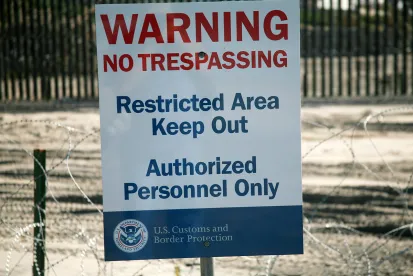Ever since the U.S. Customs and Border Protection designated intellectual property rights, or IPRs, as a priority trade issue, the agency has seized billions of dollars in counterfeit goods. In 2021 and 2022, CBP seized counterfeit goods with a total value of $3.3 billion[1] and $2.98 billion,[2] respectively. In April 2023, over $4.4 million in counterfeit jewelry bearing numerous luxury brand marks was seized in just 24 hours.[3]
For IPR holders, there are two key ways CBP enables holders to enforce their rights: (1) CBP's Intellectual Property Rights Branch recordation program; and (2) the Exclusion Order Enforcement Branch. While providing different protections, both options offer powerful ways for an IPR holder to prevent unauthorized goods from entering the U.S. market.
Best practices and recommendations for dealing with the IPR and EOE branches are outlined below.
CBP IPR Branch
Background
CBP has the authority to detain, seize, forfeit and, ultimately, destroy merchandise seeking entry into the U.S. if it bears an infringing trademark or copyright that has been registered with the U.S. Patent and Trademark Office or the U.S. Copyright Office, and then recorded with CBP.
Existing federal customs law provides for seizure and forfeiture of "merchandise or packaging in which copyright, trademark, or trade name protection violations are involved."[4]
CBP encourages all IPR holders to register their intellectual property with CBP. This can be done online, and the recordation is extendible for the life of the underlying trademark or copyright registration.[5] Trademark recordation must be renewed at the same time the trademark is renewed, and copyright recordation must be renewed every 20 years.
CBP maintains a searchable online database of recordations describing the IPR.[6] Each recordation also includes a contact person who can assist CBP in determining the authenticity of products.
CBP also operates additional programs to aid in product identification. IPR holders can submit product identification guides to the agency that identify and describe the branded product. These guides explain how to authenticate products and differentiate genuine or nongenuine goods.
IPR holders can also submit authentication tests through the Donation Acceptance Program and conduct in-person or online trainings with CBP employees.[7] The recordation database as well as the various education programs enable CBP to better identify and seize suspected counterfeit goods at the border.
In addition, an IPR holder or members of the public can file a trade violation allegation online.[8] In 2021, about 22% of the trade violation allegations submitted online were related to IPR issues.[9] Based on these e-allegations, or its own initiative, CBP can open an investigation and may detain or seize suspected nongenuine goods.
This includes investigations of goods that display a mark that is identical or substantively indistinguishable from the genuine mark (counterfeit), goods that display a mark that is likely to cause confusion or mistake by the average customer (confusingly similar), gray market goods, or goods that may be pirated.
While some investigations may take several months, others can lead to the rapid seizure of counterfeit goods at a port of entry after an e-allegation is filed.
Once CBP decides to detain suspected nongenuine goods, it will notify the importer.[10] The importer then has seven days to present information about the true nature of the goods.
CBP will also provide the IPR holder an opportunity to review information about or a sample of the suspected nongenuine goods. If the goods are determined to be nongenuine, CBP will also notify the IPR holder with details about the shipment and importer.
After seizing a shipment, CBP sends an importer a seizure notice.
The importer can then (1) request administrative forfeiture proceedings; (2) file a claim and cost bond requesting that CBP immediately refer the case to the U.S. attorney's office for a court action; (3) file a petition for administrative relief with the port director of CBP; and (4) tender an offer in compromise to the Commission of Customs through the Fines, Penalties and Forfeitures Office at the port of seizure.
Typically, these actions must be taken within 30 days.
After the seized goods are forfeited, CBP may impose a fine on the importer of nongenuine goods.[11] For the first seizure, the fine will be, at most, equal to the value of the goods if they were genuine. For any subsequent violations, the fine will be no more than twice the value.
Of note, if the seizure was based on a reported e-allegation, the reporter may be entitled to up to 25% of the levied fine or penalty.
CBP may consider mitigating factors when determining the amount of the fine but cannot eliminate the fine altogether.[12] Mitigating factors include lack of knowledge of the goods' true nature, prior record of good importation, inexperience in importation, cooperation with CBP and inability to pay the fine.
On the other hand, CBP may also consider aggravating factors such as prior importation of later seized and forfeited goods, criminal violations relating to the transaction, submission of falsified documentation, and other deceptive practices.
Best Practices
IPR holders must be proactive in enforcement to leverage the CBP programs described above to their fullest.
First, a holder should look through their trademarks and copyrights and make sure both are registered with CBP. This practice should be integrated into a broader annual portfolio review process, in which CBP recordation renewals are appropriately docketed.
Second, a holder should monitor activity related to their IPRs. This includes monitoring relevant in-person and online marketplaces, and creating a process whereby customers or the public can report suspected nongenuine goods. Automated tools are also available to make this process easier, allowing users to set up keyword alerts for trademarks or copyrights they are looking to enforce.
Third, a holder should have a formalized process for identifying and acting upon suspected nongenuine goods. This includes being educated about the enforcement process after goods are seized.
Finally, a holder should regularly review any CBP changes or additions to ensure it is taking advantage of all available programs. By fully engaging with the IPR Branch, IPR holders will be best positioned to defend their rights.
CBP EOE Branch
Background
CBP is empowered to enforce exclusion orders issued by the U.S. International Trade Commission after an unfair import, or Section 337, investigation. An IPR holder can request a Section 337 investigation if it suspects an imported good creates unfair competition with an IPR holder.
Unfair competition can arise when the imported goods infringe a U.S. patent, copyright or trademark. One remedy for an unfair import violation is an exclusion order, which prohibits the importation of the violative articles into the U.S.
This order can be a narrow limited exclusion order, excluding entry of violative goods by the specific respondents named in the investigation, or it can be a broad general exclusion order, excluding all violative goods regardless of source.[13]
CBP enforces these orders through the EOE Branch. Typically, the EOE Branch will reach out to both the IPR holder and the respondent in a Section 337 investigation to discuss how an exclusion order, if issued, would be implemented.
If the ITC issues a limited exclusion order, it typically includes a certification provision. The certification provision requires importers to self-certify that they are familiar with the terms of the limited exclusion order and that the articles being imported are not excluded under the order.[14]
Notably, this certification only permits the import of goods that were determined to not infringe the IPR rights at issue in the Section 337 investigation. It does not cover goods subsequently redesigned after the investigation or newly designed goods.
If an importer has goods that were not adjudicated in the investigation but are within its scope, it can submit a Rule 177 request.[15] This request is submitted to the EOE Branch and asks for a ruling that the unadjudicated articles are outside the scope of an exclusion order. The burden is on the importer to establish the goods are permissible, and the IPR holder has the opportunity to oppose the request.
Similar to a Section 337 investigation or court proceeding, the EOE Branch will work with the importer and IPR holder to set up a briefing schedule, including an oral discussion with the branch. This procedure moves quickly, and most decisions are reached within 90 days. Once the exclusion order takes effect, CBP will deny entry to goods covered by the order.
CBP can also seize the goods if the importer tries to bring in the covered goods multiple times. If CBP believes goods are covered by an exclusion order, it will detain them. This initiates the same detention letter and review process described above. The IPR holder can assist the EOE Branch in identifying articles subject to the exclusion order.
As an IPR holder, it is important to be aware of the variety of programs offered by CBP to assist in brand protection. The success of these programs depends, in large part, on active participation by the IPR holder. If an IPR holder receives a favorable Section 337 outcome, it can engage with the EOE Branch in enforcement procedures. The affected importer can also work with CBP to define permissible activities clearly.
Best Practices
ITC exclusion orders are solely forward-looking, and only exclude articles found by the ITC to be infringing. Therefore, respondents should consider whether they can design around the patents they are accused of infringing at the earliest possible time.
Once the exclusion order goes into effect, CBP will allow the importation of a redesigned product only if the ITC has adjudicated it as noninfringing, or if the respondent obtains a ruling from CBP that the redesign is noninfringing.
While CBP endeavors to rule on Rule 177 requests within 90 days, the delay between the submission of a request and a CBP ruling can still result in costly supply interruptions resulting from the exclusion order. Thus, redesigning a product in time for the ITC to rule on it can help a respondent avoid the cost and delay of a Rule 177 proceeding at CBP.
Respondents seeking to have the redesign adjudicated by the administrative law judge and the commission during the ITC investigation will typically be required to raise the redesign during the investigation, and actually implement and import the redesign. If the redesigned articles are adjudicated as noninfringing, CBP will allow them to be imported without any interruption from the exclusion order.
If, for cost, logistical or other reasons, it is not possible to have the redesign adjudicated in the ITC investigation, respondents should implement a redesign as soon as possible in order to show CBP that the product is noninfringing.
For complainants, before filing a complaint with the ITC, it is important to evaluate whether a design-around by the respondent can be accomplished quickly and easily. If so, complainants should reconsider their complaint, as they may end up litigating a costly Section 337 case that would ultimately yield little benefit even if they win.
Both CBP's IPR Branch and EOB Branch provide ways for IPR holders to enforce their rights. Through the IPR Branch, IPR holders can proactively assist and educate CBP with accurately identifying and seizing nongenuine goods imported into the U.S. And once an IPR holder has been granted an exclusion order by the ITC, the EOE Branch will oversee enforcement.
By utilizing the various options provided by CBP, an IPR holder can limit the entry of nongenuine or unfairly competing goods into the country.
[1] USCBP Intellectual Property Rights Seizure Statistics, Fiscal Year 2021. https://www.cbp.gov/sites/default/files/assets/documents/2022-Sep/202994 - FY 2021 IPR Seizure Statistics BOOK.5 - FINAL %28508%29.pdf.
[2] USCBP Intellectual Property Rights Seizure Statistics, Fiscal Year 2022. https://www.cbp.gov/trade/priority-issues/ipr.
[3] USCBP, "24 hours 2,400 pieces of counterfeit jewelry worth over $4.41M seized by Louisville CBP," April 7, 2023. https://www.cbp.gov/newsroom/local-media-release/24-hours-2400-pieces-counterfeit-jewelry-worth-over-441m-seized.
[4] 19 U.S.C. § 1595a(c)(2)(C).
[5] USCBP e-Recordation Form Submission. https://iprr.cbp.gov/s/erecordation-submission?temptype=New%20Recordation.
[6] Intellectual Property Rights Recordation Search. https://iprs.cbp.gov/s/.
[7] U.S. Government Accountability Office, "U.S. Ports of Entry: Update on CBP Public-Private Partnership Programs," March 14, 2019. https://www.gao.gov/assets/gao-19-263r.pdf.
[8] USCBP Trade Violations Reporting. https://www.gao.gov/assets/gao-19-263r.pdf.
[9] USCBP e-Allegations Program. https://www.cbp.gov/trade/e-allegations.
[10] USCBP Enforcement of Intellectual Property Rights, August 2012. https://www.cbp.gov/sites/default/files/assets/documents/2020-Feb/ICP-IPR-Enforcement-2012-Final.pdf.
[11] USCBP Mitigation Guidelines ICP: Trademark, Copyright, and Patent. https://www.cbp.gov/sites/default/files/assets/documents/2020-Feb/Mitigation%20Guidelines_11%20SEIZURES%20AND%20PENALTIES%20-%20Trademark%2C%20Copyright%2C%20and%20Patent.pdf.
[12] USCBP Mitigation Guidelines: Trademark, Copyright, and Other IPR Violations. https://www.cbp.gov/sites/default/files/assets/documents/2019-Apr/Mitigation%20Guidelines_11%20SEIZURES%20AND%20PENALTIES%20-%20Trademark%2C%20Copyright%2C%20and%20Other%20IPR_violations%20on%20or%20after%205-1-19_0.pdf.
[13] The ITC can impose a general exclusion order: (1) where it is necessary to prevent circumvention of an exclusion order limited to specific entities and (2) where there is a pattern of violating of Section 337, and it is difficult to identify the source of the violative articles. 19 U.S.C. § 1337(d)(2).
[14] Certain Cloud-Connected Wood-Pellet Grills and Components Thereof, Inv. No. 337-TA-1237, Limited Exclusion Order at 3 (May 12, 2022).
[15] 19 C.F.R. Sec. 177; HQ H323308 (Feb. 8, 2022).






 />i
/>i
